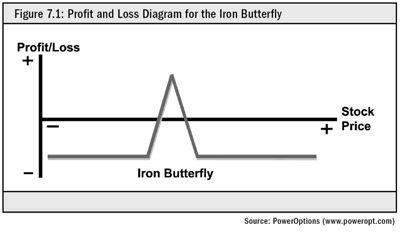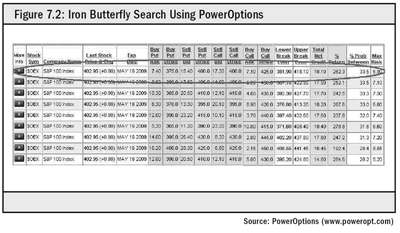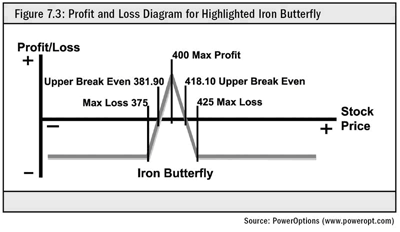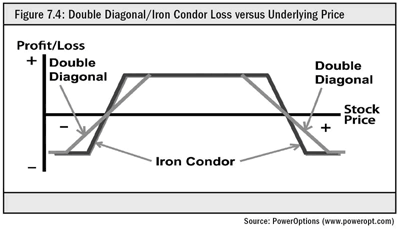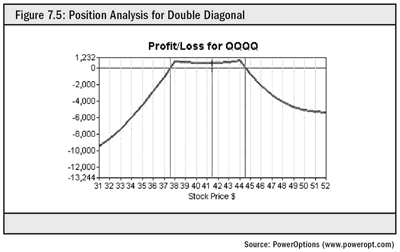The following is a free chapter from Iron Condor: Neutral Strategy for Uncommon Profit
Chapter 7: Iron Condor Variations
Iron Butterfly
The “iron butterfly” position is a special case of an iron condor where the short put options and the short call options have identical strike prices. A profit and loss diagram for the iron butterfly strategy is shown in the figure below.
As you can see in Figure 7.1, the iron butterfly has a very narrow profitability region as compared to an iron condor; however, the maximum potential profit for an iron butterfly is greater than for an iron condor, all else being equal.
An iron butterfly is best applied to securities that are stuck in a trading range and unlikely to venture from the trading range prior to expiration.
In previous iron condor, bull put, and bear call examples, the positions were selected on April 13, 2009 with the OEX index as the underlying. The search results shown in Figure 7.2 were similarly found on April 13, 2009 for the OEX index.
The returns for the iron condor, bull put, and bear call examples illustrated previously all had potential returns of less than 20% and “probabilities between” of greater than 80%. As can be seen in Figure 7.2, iron butterfly positions for OEX on April 13, 2009 have potential returns in excess of 200% and “probabilities between” of less than 35%. Although the iron butterfly positions have larger potential returns, their likelihood of generating a profit is much less.
The highlighted iron butterfly position in Figure 7.2 is entered by purchasing an OEWQO (MAY 375) put option for $7.40, selling an OXBQT (MAY 400) put option for $15.40, selling an OXBET (MAY 400) call option for $17.20, and purchasing an OXBEE (MAY 425) call option for $7.10. As can be seen, the short put option and the long call option have the same strike price of $400. The total net credit for the position is $18.10. The maximum risk for the position is $6.90, which is calculated as the total net credit subtracted from the margin requirement, or $25-$18.10. The margin requirement for the iron butterfly is the same as for the iron condor illustrated previously in Chapter 2.
Article Continues on Page 2
|pagebreak|The lower break-even point of $381.90 is calculated as total net credit subtracted from the sold put option’s strike price, or $400-$18.10. The upper break-even point of $418.10 is calculated as the sum of the total net credit and the short option’s strike price, or $400+$18.10. The lower and upper break-even points are the break-even for the position at expiration. The profit and loss diagram for the highlighted iron butterfly position is illustrated in Figure 7.3.
For an expiration price of OEX less than $375 and greater than $425, a loss is experienced for the entire amount of margin at risk, or $690 per contract.
The example OEX iron butterfly has a significantly greater maximum potential return—262%—than the previously illustrated OEX iron condor’s maximum potential return of 10.5%, but it is at the expense of a smaller profitability region and lower probability of success.
Double Diagonal
The “double diagonal” stock options position is a special case of an iron condor where the expiration month for the purchased options is further out in time than the expiration month for the sold options. For example, for short options expiring in May, the long options might expire in the June, July, or August, etc.
The main strength of the double diagonal strategy is its capability to perform in markets with low volatility; markets where a traditional iron condor has a tendency to not perform very well. The long options of the double diagonal with expiration farther out in time than the short options are more sensitive to changes in volatility. An increase in volatility will increase the value of the long options. So, for a market with low volatility in which volatility suddenly spikes, the long options of the double diagonal increase in value relative to the short options; this aids in increasing profitability or ameliorating a loss.
Another strength of the double diagonal strategy is how the wings of the iron condor tend to fall off more slowly with respect to the movement of the underlying, as illustrated in Figure 7.4.
For example, consider the double diagonal position for ETF QQQQ as illustrated in Table 7.1.
A profit and loss graph for the QQQQ double diagonal position, as illustrated in Table 7.1, generated by the PowerOptions Position Analysis tool, is shown in Figure 7.5.
Let’s compare the double diagonal position just illustrated with an iron condor position as shown in Table 7.2. The iron condor position has the same short stock options, but different long stock options. The double diagonal has long options with expiration in November versus the iron condor, which has long options with expiration in October.
A profit and loss graph for the QQQQ iron condor position, as illustrated in Table 7.2, generated by the PowerOptions Position Analysis tool, is shown in Figure 7.6.
As illustrated in Figures 7.5 and 7.6, the double diagonal has a much slower rate of loss over the iron condor, as the price of the underlying transitions to less than the short put strike price, or as the price of the underlying transitions to greater than the short call strike price.
In general, a stop loss for a double diagonal will incur a smaller loss than for an iron condor, all else being equal.
Article Continues on Page 3
|pagebreak|Double diagonals have several disadvantages compared to iron condors:
They are not eligible for special margin;
They require large amounts of capital for indexes (alternative is ETFs);
They are not eligible for special tax considerations with ETFs;
Their profitability region is generally not as wide as an iron condor;
Their return calculation is not as straightforward as an iron condor; and,
They require more management than an iron condor.
No Special Margin
A drawback to the double diagonal is that brokers generally do not provide special margin for the position because all of the options do not have the same month of expiration.
Large Capital Requirement for Indexes
Additionally, double diagonals for index positions with wide profitability regions tend to require a significant amount of capital per contract. For example, a double diagonal position for an index might require $25,000 for one contract, which is out of reach for many investors. Or, a double diagonal position may not allow investors to adequately diversify their portfolios.
On the other hand, double diagonal positions with fairly wide profitability regions can typically be entered for ETFs for only a couple thousand dollars. Unfortunately, double diagonals with ETFs as the underlying do not allow investors to take advantage of the special tax considerations available for an iron condor with an index as the underlying.
Smaller Profitability Region
In general, a double diagonal position will not have as wide a profitability region as an iron condor, all else being equal.
Return Calculation Complicated
The maximum potential return calculation for double diagonals is not as straightforward as for iron condors. The return calculation for double diagonals does not assume the value of the long options will be zero at the expiration of the short options, as in the case with iron condors. The long options for the double diagonal are further out in time and will not expire simultaneously with the short options, and will have some quantity of value at the expiration of the short option.
The value for the long options at the short option expiration is commonly calculated via the Black-Scholes option pricing model. The value derived from this model is dependent on the volatility of the stock market, which is subject to change and assumes the stock market behaves in a Gaussian manner. Assuming the market behaves in a Gaussian manner is a source of inaccuracy for options, as discussed in Chapter 2, especially for options significantly out-of-the-money as in the case of the long options for the double diagonal strategy. Based on this, the theoretical potential return calculation for a double diagonal position should be considered approximate and not as firm as for the iron condor.
Require More Management
For profitable positions, double diagonals require more management than iron condors. Profitable iron condor positions typically require no additional management, as the options all expire worthless. Conversely, profitable double diagonals require investors to close or roll the long option positions at some point. Also, since the profitability regions of double diagonals are typically smaller than iron condors, more management of the positions is required for rolling the trades.
Review Questions for Chapter 7
1. Advantages of the double diagonal as compared to the iron condor are:
A. Can perform in low volatile market conditions
B. Generally incurs a smaller loss after a stop loss is experienced
C. All of the above
D. None of the above
2. Disadvantages of the double diagonal as compared to the iron condor are:
A. Not eligible for special margin
B. Profitability region generally not as wide
C. Requires more management
D. All of the above
E. None of the above
3. Trading iron butterflies is best suited for stocks that:
A. Have wide price swings
B. Are stuck in a trading range
C. Are in the Iron Flower industry
4. Compared to iron condors, iron butterflies:
A. Have more potential return, all else being equal
B. Have less potential return, all else being equal
C. Come from iron caterpillars
D. Are hatched from iron eggs
By Ernie Zerenner and Michael Phillips

